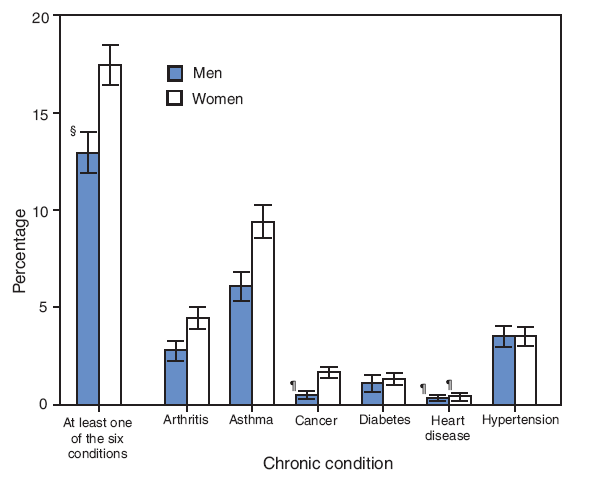Persons using assistive technology might not be able to fully access information in this file. For assistance, please send e-mail to: mmwrq@cdc.gov. Type 508 Accommodation and the title of the report in the subject line of e-mail.
QuickStats: Percentage of Young Adults Aged 18--29 Years* with Selected Chronic Conditions,† by Sex --- National Health Interview Survey, United States, 2005--2007

* Overall respondents: 6,898 men and 8,532 women.
† Estimates are based on household interviews with a sample of the civilian, noninstitutionalized, adult U.S. population. The prevalence of diagnosed chronic conditions was determined by asking respondents if a doctor or other health professional ever told them that they had a specified condition. Asthma estimates are for current asthma and are based on the additional question "Do you still have asthma?" Arthritis includes arthritis, rheumatoid arthritis, gout, lupus, and fibromyalgia. Cancer excludes nonmelanoma skin cancer or skin cancer of unknown type. Diabetes includes all types with the exception of diabetic conditions related to pregnancy. Heart disease includes coronary heart disease, angina or angina pectoris, or heart attack or myocardial infarction. Hypertension is based on respondents indicating that on two or more separate visits they were told by a doctor or health professional that they had hypertension. Young adults who reported more than one condition are counted in each category.
§ 95% confidence interval.
¶ Estimate is statistically unreliable; data have a relative standard error of 20%--30%.
During 2005--2007, young women aged 18--29 years (17.4%) were more likely to report having at least one of six selected chronic conditions than young men (12.9%) in the same age group. For both young men and young women, asthma, arthritis, and hypertension were the three most common of the six conditions. Greater percentages of women than men reported having asthma, arthritis, or cancer; similar percentages of women and men reported having hypertension or diabetes.
SOURCE: National Health Inteview Survey data files, 2005, 2006, and 2007. Available at http://www.cdc.gov/nchs/nhis.htm.
Alternative Text: The figure above shows the percentage of young adults aged 18-29 years with selected chronic conditions, by sex, from the National Health Interview Survey, during 2005 through 2007. During 2005-2007, young women aged 18-29 years (17.4%) were more likely to report having at least one of six chronic conditions than young men (12.9%) in the same age group. For both young men and young women, asthma, arthritis, and hypertension were the most common of the six conditions. Greater percentages of women than men reported having asthma, arthritis, or cancer; similar percentages of women and men reported having hypertension or diabetes.
Use of trade names and commercial sources is for identification only and does not imply endorsement by the U.S. Department of
Health and Human Services. |
All MMWR HTML versions of articles are electronic conversions from typeset documents. This conversion might result in character translation or format errors in the HTML version. Users are referred to the electronic PDF version (http://www.cdc.gov/mmwr) and/or the original MMWR paper copy for printable versions of official text, figures, and tables. An original paper copy of this issue can be obtained from the Superintendent of Documents, U.S. Government Printing Office (GPO), Washington, DC 20402-9371; telephone: (202) 512-1800. Contact GPO for current prices.
**Questions or messages regarding errors in formatting should be addressed to mmwrq@cdc.gov.Date last reviewed: 7/2/2009


